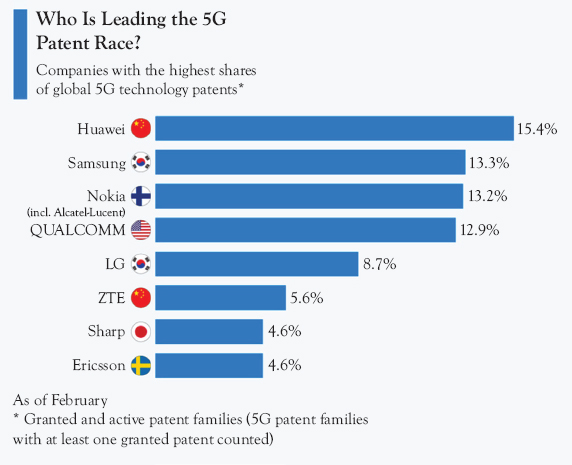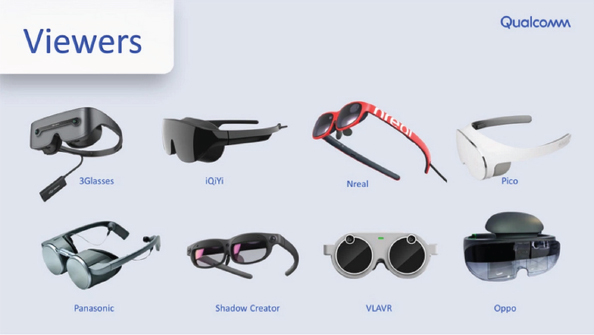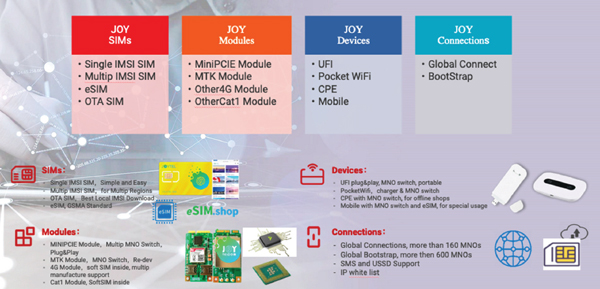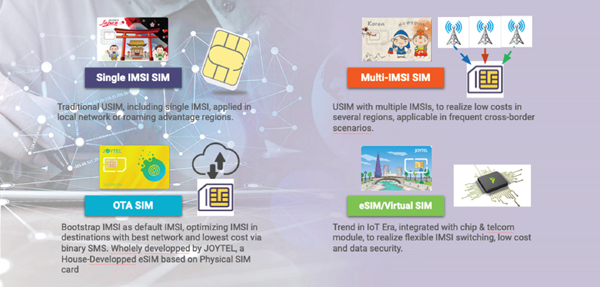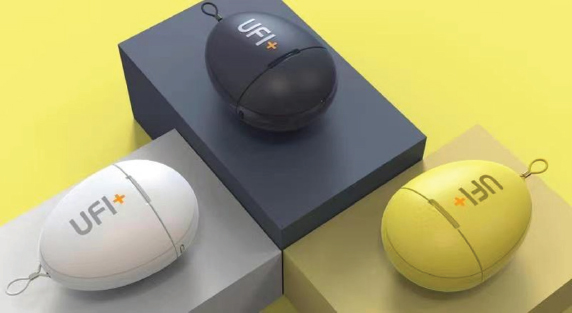A Brief History of Communication
From 1G to 5G, what have we experienced?
1G—The first commercially automated cellular network (the 1G generation) was launched in Japan by Nippon Telegraph and Telephone (NTT) in 1979. In order to facilitate communication between senders and receivers, standards for communication were needed. The early mobile communication standard was dominated by the standard set by Motorola. There are two important parts of this: (1) Describe the sending and receiving of information, that is, the phone number and (2) The way the information is encoded.
2G—In the 1980s, companies represented by Nokia began to develop a new generation of mobile communication devices that could make calls and send text messages. 2G cellular networks were commercially launched on the GSM standard in Finland by Radiolinja (now part of Elisa Oyj) in 1991. From the appearance, 2G mobile phones were much smaller than 1G phones, because the digital circuit used for 2G mobile phones could integrate more digital chips and save more power.
3G—The 3G communication standard increased the transmission rate of information by an order of magnitude, making it possible to access the mobile Internet. In June 2001, Japanese telco company NTT DoCoMo started a trial 3G service in a few selected areas. Data communication was possible. However, when we look back, we will find that the mobile communication network for Internet access and the original communication network for phone calls are independent of each other, and we call it a completely independent cellular mobile network (wide area cell-based network). This was the reason why we often saw fixed-line telephone companies like AT&T and mobile communication companies like Motorola always competing with each other during that time.
4G—Internet is faster. A 4G network is a combination of a wireless local area network (Wi-Fi is one of them) and a cellular network. TeliaSonera was the first operator in the world to commercially launch 4G in late 2009, in the city centers of Stockholm, Sweden, and Oslo, Norway. 4G reduces the number of times information can be forwarded during end-to-end communications. It also increases the bandwidth of the fiber between base stations. The problem is that if a lot of people are online at the same time, it is not only not fast enough, it cannot even connect. It is like there are too many vehicles on the highway, not only can’t you drive fast enough, you even have to wait in line at the entrance.
How to solve this problem?
There are two ways to increase the Internet speed:
1. Increase base station power—This is not feasible in cities because the surrounding area of the base station will become unsafe due to the strong electromagnetic radiation.
2. Continue to increase the bandwidth—This will increase the frequency range of communication and increase the frequency of radio waves. The higher the frequency of a radio wave, the less able it is to bypass obstacles. Therefore, the high-rise buildings in the city will seriously affect the communication quality. What to do? The simpler way is to build the base stations very densely so that at least there is a base station in your neighborhood, and the signal will not be blocked by buildings.
5G—The 4G standard is to establish a base station within a 1 km radius, responsible for communication between mobile phones and base stations within a radius of 1 km. South Korea was the first country to offer 5G services in March 2019. According to the current scenario, the average distance between 5G base stations is around 200 and 300 m. Responsible for communication within a radius of more than 100 m. In this way:
• The problem of buildings interfering with communication signals is solved.
• The bandwidth available to everyone has increased.
• As the communication range of the base station is reduced from 1 km to 100 m, the power is reduced and the electromagnetic wave radiation around the base station is greatly reduced.
If 5G base stations are dense enough, we will not need to install Wi-Fi at home so that eventually the Internet and communication networks will merge into one network, completing the communication revolution.
The development history of mobile communication from 1G to 5G is a process of continuously improving the information transmission rate per unit of energy, reducing the radiation of mobile devices and integrating the mobile Internet. 5G needs more base stations not necessarily because of the frequency band and larger bandwidth demand, but also because of the need to support more terminals (driven by IoT demand) and low latency (driven by applications such as Telematics, VR (virtual reality) Gaming, etc.).
Why Do We Need 5G?
It is estimated that in the next five years, half of the global data traffic will no longer come from people’s use, but will be generated by vehicles, machines, meters, sensors, medical instruments, or various other types of connected devices without any human interaction.
The widespread use of 5G technology ensures that large amounts of data can be processed and responded quickly in real time. For example, connecting industrial machinery and robots, thus enabling remote control, monitoring and maintenance operations, and industrial automation. From smart grids to drone control, energy and utilities, all can rely on 5G technology to handle connectivity needs.
In 2020 and beyond, the mobile Internet will drive further upgrades in the way human society interacts with information, providing users with more immersive and extreme business experiences such as augmented reality, virtual reality, three-dimensional (3D) ultra-high-definition video, and mobile cloud. The further development of the mobile Internet will bring a 1,000-fold increase in mobile traffic in the future and drive a new round of changes in mobile communication technology and industry. The IoT extends the scope of mobile communication services from human-to-human communication to intelligent interconnection of things and people, enabling mobile communication technology to penetrate into a wider range of industries and fields. According to the forecast of IPlytics, it is estimated that in the next 15 years, the global adoption of 5G technology will contribute up to $2 trillion to the global economy.1
Is the 5G Rollout Slow Worldwide?
5G has been rapidly becoming mainstream. According to a Global Mobile Suppliers Association’s (GSA) report, as of June 2021, 58 countries/regions around the world already have 5G networks, up from 38 a year ago.

There are more than a dozen companies that have partially deployed 5G mobile technology. In terms of the number of years of reaching one billion users, it is estimated that 5G will reach one billion users in 3.5 years, while 4G was four years and 3G was 12 years.
GSA 5G snapshot
Source: Statista.
Who Is Leading the Global 5G Race?
This depends on the analytical factors you wish to use. If you look at the number of 5G patents owned by a single company, according to the statistics report of IPlytics, the Chinese manufacturer Huawei has more than 15 percent of the authorized and valid patents worldwide, ranking first in the world. If calculated according to the sum of the number of 5G patents of companies in various countries, South Korea’s Samsung and LG together slightly exceeded China.2
Huawei’s technical strength comes from Huawei’s large-scale investment in research and development (R&D). For example, in 2017, Huawei spent $13 billion on R&D, more than any other Chinese tech company and more than the combined R&D spending of its main competitors Ericsson and Nokia.
Among these patented technologies of Huawei, some are fundamental to the construction of 5G networks. For example, a technology called polar coding can correct data transmission errors. This technology was partially adopted as an official 5G standard in 2016. This means that even if countries, including the United States, Australia and New Zealand, have banned Huawei from participating in 5G network construction, they will have to use Huawei’s authorized patents.
Who is leading the 5G patent race?
Source: IPlytics.
As of February 2021.
*Granted and active patent families (5G SEP patent families with at least one granted patent counted).
On October 31, 2020, China’s three major telecom operators announced the official launch of 5G technology. According to a report by the State Council Information Office, China built more than 600,000 5G base stations in 2020, achieving full coverage of 5G networks in all cities above the prefecture level; the number of 5G terminal connections has exceeded 200 million. The number of 5G+ industrial Internet projects has exceeded 1,100. 5G+ remote consultations have been used in more than 60 hospitals in 19 provinces. New models and new formats such as 5G+ autonomous driving, 5G+ smart grid, and 5G+ distance education are emerging.
What Are the Current Applications of 5G?
5G has the characteristics of high speed, wide connection, high reliability, and low latency. 5G typical application scenarios include enhanced mobile broadband (eMBB), ultra-reliable low-latency communication (uRLLC), and massive machine-based communication (mMTC).
One commercial area of 5G is 5G drones.
Qualcomm Flight RB5 5G Platform
In August 2021, Qualcomm launched the Qualcomm Flight RB5 5G platform, which is the world’s first drone platform and reference design that provides 5G and AI functions.
The Qualcomm Flight RB5 5G platform is designed based on its high-quality robot platform, providing powerful low-power heterogeneous computing through artificial intelligence (AI), 5G and remote Wi-Fi 6 connections, providing 15 TOPS and supporting seven cameras concurrency.3
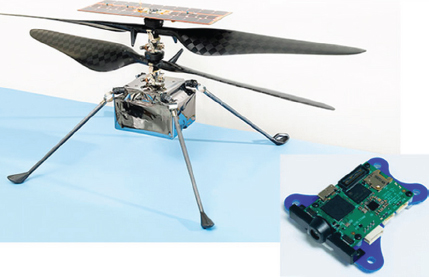
The Qualcomm Flight RB5 5G platform
Source: Qualcomm.
Incidentally, Qualcomm’s flight platform is the platform used by the Ingenuity Helicopter small robotic helicopter that took off and landed vertically on Mars in the NASA Mars 2020 mission.

Ingenuity Helicopter small robotic helicopter
Source: NASA.
The Qualcomm Flight RB5 5G platform currently supports more than 200 robot and drone ecosystem members worldwide and promotes the global standardization of 5G drones in organizations such as 3GPP, GSMA, the Global UTM Alliance, the Joint Air Connect Initiative (ACJA), and ASTM. This platform will support evolving applications and new 5G application scenarios in the fields of film and entertainment, security and emergency response, delivery, national defense, inspection, surveying, and mapping.
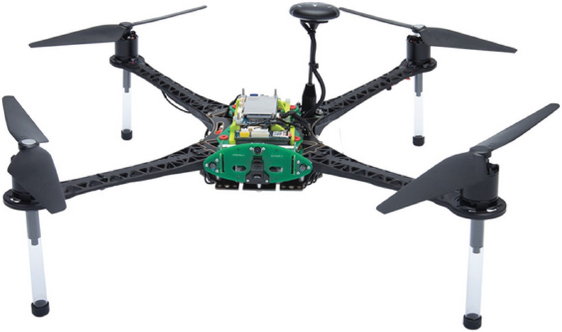
The Qualcomm Flight RB5 5G platform
Source: Qualcomm.
Vodafone Precise Positioning Technology
Speaking of 5G drones, I would like to mention precise positioning technology here. British telecommunications company Vodafone and global navigation company Sapcorda have successfully tried out new precision positioning technology. Vodafone uses Sapcorda’s latest-generation Global Navigation System Service (GNSS) correction service’s precise point location-real-time kinematics (PPP-RTK) technology to accurately track the lanes the vehicle travels in a 100-km journey.
This technology can provide accurate positions for vehicles, machinery, and equipment of the IoT by correcting factors such as the curvature of the earth, atmospheric delay, and the time difference of global positioning satellites, increasing the accuracy from 3 m to 10 cm.
This precise positioning service provided by Vodafone is an important supplement to its “Telecom as a Service” (TaaS) model, and precise positioning is critical to the popularization of autonomous vehicles.
Vodafone precise positioning technology
Source: Vodafone.
“Flying Jiuzhai” Cloud Experience Live Broadcasting Platform
A typical business case for 5G drones in China is the 5G Leap Jiuzhai cloud experience live broadcast platform exclusively built by China Telecom Sichuan Company. The 5G drones they used can last for more than 30 minutes, with a maximum range of up to 12 km and a flying altitude of up to 1 km. Visitors can experience flying into the environment through this platform without leaving home, and feel the beauty of Jiuzhai that cannot be experienced walking on the plank road.

Source: Jiuzhaigou National Nature Reserve.
Video version (www.youtube.com/watch?v=qUxbbGKFqyY).
What Are the First Killer Applications Supported by 5G?
One of the first killer applications supported by 5G is XR, known as extended reality. XR encompasses augmented reality (AR), virtual reality (VR), mixed reality (MR), and everything in between.
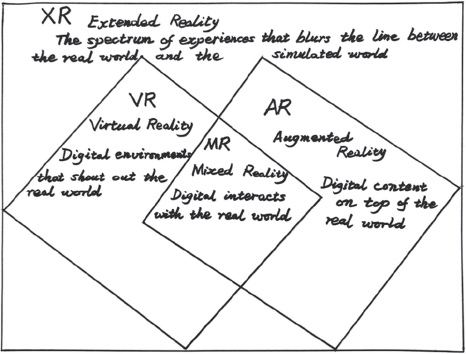
Hand-drawn by Sam Luo, XR/VR/MR/AR
When it comes to extended reality, Qualcomm has to come to mind. We know that Qualcomm supplies the chips and software for most of the world’s best-known VR and AR headsets, so it has a unique advantage to build an XR ecosystem. Qualcomm sees XR as the future of mobile computing, and Qualcomm is also pushing to make mobile XR a reality.

Extended Reality (XR): The first killer application supported by 5G
The XR viewer is a lightweight headset that connects to smartphones powered by Qualcomm Snapdragon 855 or 865 mobile platforms. The XR viewer produced at this stage can be tethered to a 5G-enabled smartphone via a USB-C cable. Over the next one to four years, wired XR viewers will transition to a completely wireless connection, but still use the host device for processing and network (5G) connectivity. Of course, standalone XR devices will become lighter and sleeker in the future.
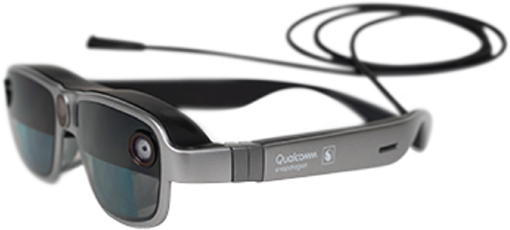
The XR viewer
Source: Qualcomm.
The XR viewers unlock a new generation of immersive experiences using 5G-enabled smartphones that deliver the high bandwidth and low latency that are essential for high-quality XR. Mobile phone applications can become an AR experience at hand, or they can revolutionize workplace meetings through holographic telepresence technology through a virtual collaboration platform. Together, XR and 5G will change the way the world connects, communicates, and consumes content.
Many manufacturers are currently developing XR viewers, including iQIYI and OPPO. In the future, they will provide consumers with a new XR experience through smartphones that support 5G functions such as OPPO, VIVO, ZTE, and so on.
The viewers
Source: Qualcomm.
But XR viewers still need to solve five major technical challenges, including:
• Display: Display richer visual content, and seamlessly switch between full and partial virtual worlds.
• General lighting: Make virtual objects in the enhanced world indistinguishable from real objects in the same view.
• Motion tracking: Intelligent, fully on-device tracking, which enables intuitive head, hand, and eye interaction.
• Power and heat: All-day battery life-rechargeable years, and compatible with sleek, thin, light fanless passive cooling devices.
• Connectivity: The next level of ubiquitous wireless connectivity, used anywhere at fiber speed.
Qualcomm XR Optimization Certification Program
The Qualcomm XR Optimized Certification Program tests the performance of XR viewers and verifies compatibility between XR viewers and smartphones to ensure user experience. There are currently two certifications, one for smartphones and one for XR viewers to allow original equipment manufacturers (OEMs) (smartphones and viewers) to verify optimizations across multiple smartphones and multiple viewers, without requiring them to perform one-to-one optimizations.
Smartphone OEMs that plan to provide users with a new XR experience through 5G-enabled smartphones such as ASUS, Black Shark, OnePlus, OPPO, Smartisan, vivo, ZTE, and so on.
China’s three major telecom operators are actively deploying XR:
XR Deployment Strategy—China Mobile
XR is one of the first killer applications supported by 5G and one of China Mobile’s key businesses in the 5G era. China Mobile will cooperate with Qualcomm Technologies and other companies to continuously explore technological innovations for 5G + XR applications. The Qualcomm Technologies ecosystem is working hard to introduce the XR viewer category, and we plan to explore other application scenarios to open up new XR horizons for 5G for end users.
—Wang Hengjiang, Deputy General Manager, China Mobile
Group Equipment Co., Ltd.
XR Deployment Strategy—China Telecom
The transformative technology of 5G connectivity has become a new driver of social and economic development, and has had a profound impact on society in the past like steam and electricity. We are very excited to combine our strengths in 5G and cloud network collaboration with Qualcomm Technologies’ leading XR technology to fully leverage their technical expertise and jointly drive 5G and XR deployments in the industrial, healthcare, education and consumer sectors.
—Chen Li, Deputy General Manager of Tianyi Telecom
Terminal Co., Ltd.
XR Deployment Strategy—China Unicom
Enabling the high bandwidth and low latency of 5G, coupled with the immersive and interactive experience that XR provides, will make a huge difference across the entire industry. China Unicom has joined forces with 21 XR companies, including Qualcomm Technologies, to create our 5G XR ecosystem.
Qualcomm Technologies’ efforts to enable commercial deployment of XR viewers for 5G smartphones, including the Qualcomm XR Optimization Certification Program, will help the 5G XR ecosystem steadily mature after its launch in 2020.
—Vice President, China Unicom and Channel Support Center,
Unicom Huasheng Communications Co.
Video version (www.youtube.com/watch?v=F4yDfihXRAA).
IoT
What Is the IoT?
The concept of IoT and the term itself first appeared in Peter T. Lewis’s speech at the Congressional Black Caucus Foundation’s 15th Annual Legislative Weekend in Washington, DC, September 1985.4 According to Lewis, “The Internet of Things, or IoT, is the integration of people, processes and technologies with connectable devices and sensors to enable remote monitoring, status, manipulation, and trend assessment of such devices.”
The main theme of the IoT is to embed short-range mobile transceivers in various gadgets and daily necessities to enable new forms of communication between people and things, and between things themselves.
Why Do 5G and IoT Always Appear in Pairs?
We often hear about IoT when talking about 5G. In fact, 5G and IoT describe people’s requirements for the future Internet from different perspectives.
When we talk about IoT, we hope that everything in the world will be connected to the Internet, the so-called Internet of everything. On the other hand, talking about 5G is to hope that the network speed in the future will be faster than now, and it will be able to support more devices and people to access the Internet, as well as the integration of various networks (no need to switch to Wi-Fi mode indoors).
What Are the Components of IoT?
The components of IoT mainly include the following aspects:
• IoT terminal devices—that is, sensors, meters, wearables, automobiles, home energy management systems (HEMS), PCs, smartphones, and so on
• Network—Wi-Fi, Bluetooth Low Energy (BLE), Zigbee, 3G, 4G, 5G, fiber to the home (FTTH)
• IoT platforms—Cloud, big data storage, and analysis
• IoT service applications—Services based on data, such as recommendation, predictive analysis, and so on; automated management applications, such as smart transportation and smart cities, and so on
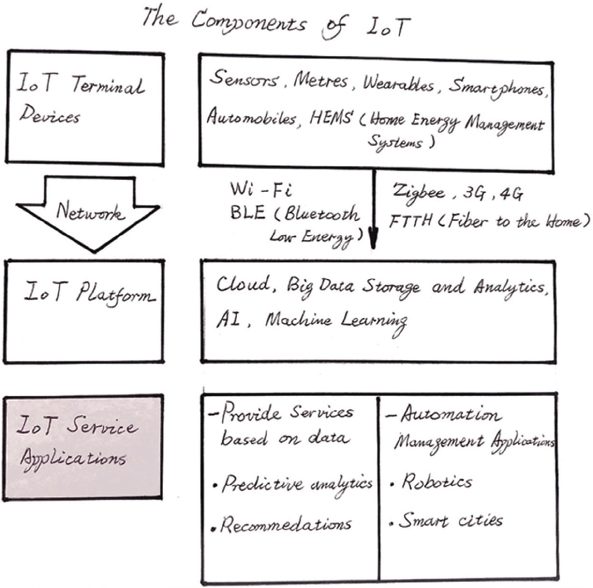
The components of IoT
Source: Image hand-drawn by Sam Luo
IoT Use Case—Smart Agriculture
IoT has been widely used in agriculture. With IoT devices, farmers are able to keep track of soil and air moisture levels so that they can water precisely, grow healthier crops, achieve greater yields, save a lot of water, and significantly reduce farming costs. Let me introduce a typical use case of smart agriculture solution.
IoT use case—smart agriculture
Do you know which company provides more than half of the vegetable supply of Chinese KFC and Pizza Hut?
It’s Qingdao Haofeng. Let us take tomato planting as an example to explain how Qingdao Haofeng used smart agriculture solutions to increase productivity and lower costs.
The cycle of a tomato from planting to fruiting is about 90 days. In this process, the requirements for temperature, humidity, light, mineral elements, fertilizer, and carbon dioxide are different. The traditional planting method is open-air planting. The amount of watering and fertilizing is the same every day. This way actually wastes a lot of water and fertilizer.
In October 2017, a smart agricultural greenhouse was put into operation in Dezhou, Shandong province. The size is equivalent to 10 football fields large, and it could plant 120,000 tomatoes. The greenhouse was equipped with various sensors and cameras, which transmitted the collected data such as humidity and moisture to the central control system in the cloud to compare with the parameters under the optimal growth conditions. Then the system automatically controls the devices in the greenhouse, such as lighting equipment, water and fertilizer delivery system, and so on, and adjusts the temperature, light, and moisture environment in the greenhouse to the best condition for tomato growth.
Qingdao Haofeng Smart Agricultural Greenhouse
Source: Qingdao Haofeng.
The system can also combine different parameters to minimize the cost of tomato planting. Not only that, the intelligent agricultural system can also automatically control the growth rate of tomatoes according to market conditions. For example, the ripening cycle of tomatoes is usually 60 days. When the supply of tomatoes on the market exceeds the demand or the demand is insufficient, the system can adjust the production environment to appropriately accelerate or delay the ripening of tomatoes so as to sell them at the best timing.

Tomatoes growing in the smart greenhouse
Source: Qingdao Haofeng.
Tomatoes grown in smart greenhouses are uniform in size, better in appearance, and have a better taste. The price can also be sold at one to two times that of other varieties on the market. The specific parameters are shown in Table 2.1.
Table 2.1 Comparison of tomato parameters in different planting methods
Planting method | Seedling height (m) | Output (kg/m²) | Selling price (yuan/kg) |
Traditional open-air planting | 2 | 8 | 10 |
Ordinary agricultural greenhouse | 3 | 17 | 10 |
Smart greenhouse | 15 | 85 | 20 |
With the improvement of the collection and analysis of agricultural big data, the smart agriculture solutions will grow vegetables and fruits with better quality and taste at a lower cost.
Video version (www.youtube.com/watch?v=i4xgR1JpnbA).
IoT Use Case—Global IoT Operator
The IoT market is vast, the industry chain is huge and complex, customer needs are ever-changing, and solutions vary. In particular, mobile network-based IoT solutions have gathered various players from chips, modules, devices, connections, platforms, and so on. How to integrate global mobile network resources and provide customers with an end-to-end solution has always been one of the pain points in this industry.
Here I introduce a global IoT operator based on the current mobile cellular network—JoyTelecom (www.joytelecom.com).
JoyTelecom is a licensed full virtual mobile operator with its own core network elements in Hong Kong. Compared to traditional operators, JoyTelecom has a full set of network equipment without setting up the radio infrastructure such as radio stations (access network), and therefore has full service control and billing capabilities. Through its globally deployed regional nodes, JoyTelecom integrates mobile network operators around the world and delivers global mobile network connectivity solutions to customers’ terminals through a unified platform for scheduling and distribution. It ensures that both corporate and individual customers can enjoy local or at least regional high-quality services at each location.
JoyTelecom has developed and launched six SaaS service platforms and 14 terminal products in four categories in the process of global business development, basically covering all the current needs based on mobile cellular networks.
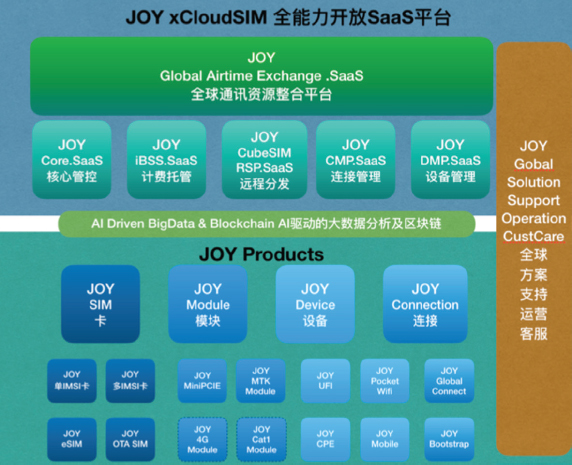
JoyTelecom xCloudSIM SaaS
Source: JoyTelecom.
Through these six major platforms and 14 kinds of terminal products, JoyTelecom serves two types of customer groups:
1. One is business-to-business (B2B) enterprise IoT solutions
2. The other is business-to-customer (B2C) global mobility crowd
In the enterprise solution, JoyTelecom offers connected USB devices and IoT services to provide data transmission services for a large international medical device company in China. From IoT connectivity service, connected hardware, terminal software development to the final implementation, the project provides an end-to-end most convenient solution that meets the customer’s expectations in full accordance with the customer’s demands and combined with JoyTelecom’s product solutions.
The module products provided by JoyTelecom are integrated into SD-WAN devices to achieve 4G network backup and network switching in the offline chain industry, and increase the SD-WAN service service-level agreements (SLAs) to 99.9 percent.5
For the cross-border population, JoyTelecom provides services ranging from simple SIM cards to UFI devices, serving more than five million people annually and consuming more than 45T of data per day. JOYAL has brought a lot of revenue to many mobile operators and has maintained a long-term mutually beneficial relationship.
The core competitiveness of JoyTelecom is to provide an end-to-end IoT solution from global resource integration, platform services, to providing customers with connected hardware.
Joy CubeSim
JoyTelecom supports multiple SIM technologies. Apart from physical SIM, JoyTelecom also supports vSIM, softSIM, and eSIM. Joy CubeSIM is an independent remote SIM provisioning (SIM RSP) that can remotely manage and distribute all kinds of SIMs and can allow devices and users to switch network services in real time according to their geographic location, preferences, and so on. With this platform and the regional local resources provided by JoyTelecom global network, it is able to provide customers with the best network quality and competitive tariff for connectivity services.
JOYEGG—A UFI (USB Wi-Fi) Product
JOYEGG is the latest development of a practical and compact UFI product (USB Wi-Fi modem, USB wireless modem). JOYEGG converts 2G, 3G, 4G (5G is on roadmap) to Wi-Fi, suitable for home office Wi-Fi sharing, corporate secure internal network access, and cross-border and business travelers.
Compared to traditional Wi-Fi devices, JOYEGG is easy to operate, plug and play, and supports a total of 21 bands of mobile networks worldwide. It can remotely download local SIM profiles, and switch to the preferred networks at any time. This allows customers to choose competitively priced and high-quality networks, all done remotely without any manual operation on the device.
JoyTelecom’s products
Source: JoyTelecom.
Joy CubeSIM product category
Source: JoyTelecom.
JOYEGG
Source: JoyTelecom.
VR Application in the Medical Field
What is the third leading cause of death in the world? Do you think it is car accidents or medical accidents?
The correct answer is medical accidents. One reason is that the common method for surgeons to train medical students or prepare for surgery is usually to plan and practice surgery on a generic two-dimensional model of the human body. This makes it extremely difficult to accurately treat each patient, especially during surgery.
As the COVID-19 has surged around the world, many operating rooms have been asked to make room for infected patients. But the price of doing so is that for many surgeons and medical students around the world, surgical practice has basically ceased. How to solve this problem?
VR technology combined with 3D printing technology can provide a realistic surgical training environment for surgeons and medical students. I use brain surgery as an example here.
First, the VR system will build a 3D model of a real patient’s unique brain anatomy based on the MRI, CT scans, and angiograms so that neurosurgeons can explore each patient’s arteries, bones, and tissues accurately, and plan the surgery and even practice the upcoming brain surgery on the 3D model.
Brain surgeons also use this system to introduce their patients to their conditions. Compared to 2D flat drawings, the 3D brain anatomy is more realistic. Doctors can use this system to show the patient’s problem areas and the entire surgical procedure, allowing the patient to better understand the details of the operation, deepen their understanding, have more confidence in their doctors, and reduce unnecessary doctor–patient conflicts.

What are the new opportunities for VR in the medical field?
Are there any start-ups in VR surgery simulation?
The start-up I want to introduce today is Surgical Theater. They have developed a surgical training platform (SRP) for neurosurgery preoperative planning and training. Established in 2011, it has offices in Netanya, Israel, and Cleveland, Ohio, United States. Its medical VR (mVR) division is headquartered in Los Angeles.
Surgical Theater has raised a total of $11.1 million in four funding rounds. Their most recent funding was $9 million on October 19, 2015, from HTC. HTC is a Taiwan-based company that designs, develops, and manufactures VR hardware, smartphones, and tablet computers. It is the world’s largest manufacturer of Windows mobile phones.
Surgical Theater claims to be the only verified 360° XR system for surgery currently on the market, with seven registered patents mainly in the computing category.
Video version (www.youtube.com/watch?v=rkZwE1BX3v4).
6G
In October 2020, Microsoft, Qualcomm, Samsung, HP, and other companies formed an alliance called the Next G Alliance, or 6G Alliance. A month later, Apple and Google joined the 6G Alliance, along with a large group of companies. 5G is not yet fully popularized, why do we need 6G?6
Why Do We Still Need 6G?
One of the reasons for the development of 6G is to support VR. This virtual reality includes, in addition to 3D images, other dimensions of sensory information, such as smell, taste, and touch information transmission issues, making the virtual world more and more realistic.
In the 6G era, the functions of IoT devices will be further expanded. In addition to the existing image and voice functions, other sensory information including smell will also be added.
Another reason to develop 6G is to be able to run smarter AI technology. Most of the current AI technology needs to rely on remote servers. Although many machine translation software can already provide voice translation, the current accuracy needs to be improved to perform real-time translation for two talkers who do not understand each other’s language when making a phone call. This type of application requires 6G to be more than 50 times faster than 5G, and latency needs to be reduced by another order of magnitude.
What Is the Current Development Status of 6G?
In June 2019, Neil McRae, chief network architect of British Telecom Group (BT), predicted that 6G will be commercially available in 2025, with features such as 5G+ satellite network (communication, telemetry, and navigation), wireless fiber, and other technologies.7
In addition to the Next G Alliance established in October 2020, the European Union launched Horizon Europe (2021–2027) in 2020 to conduct research on six key technologies, including next-generation networks, and officially launched the European Commission Flagship research project to define the future of 6G, Hexa-X, in December 2020.8,9
In June 2019, the Ministry of Industry and Information Technology of China established the IMT-2030 (6G) research group, including the demand group, wireless group, network group, spectrum group, standards group, and international cooperation group, officially launching the 6G research process in China.
Xiang Ligang, a high-level consultant on high-quality development of China’s Ministry of Industry and Information Technology, believes that
6G will focus on three future breakthroughs and advances, one is the integration of heaven and earth, the other is to enter the era of terahertz frequencies, the density of base stations will increase, and the third is to establish a fully intelligent network system. Meanwhile, more complex application scenarios such as metaverse, inter-machine collaboration, and fully intelligent transportation are also expected to be further realized in the 6G era.
Nikkei, in collaboration with Tokyo-based research firm Cyber Creative Institute, surveyed nearly 20,000 patent applications for nine core technologies in the 6G space, including communications, quantum technologies, base stations, and AI.10 According to the report, China accounted for 40.3 percent of the global 6G patent applications, followed by the United States with 35.2 percent. Japan accounted for 9.9 percent, Europe for 8.9 percent, and South Korea for 4.2 percent.
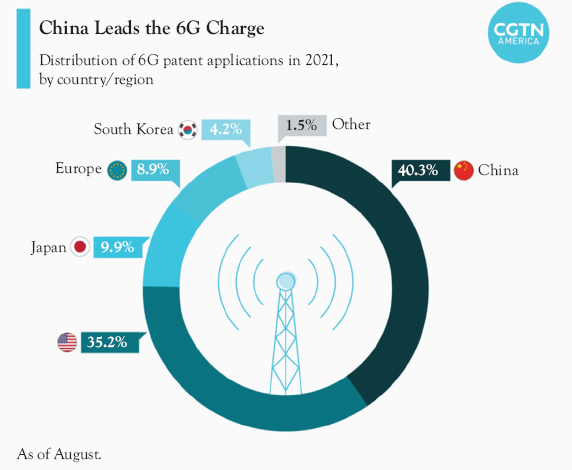
Source: Cyber Creative Institute via Nikkei Asia/Statista; as of August 2021, China leads the 6G charge.
The majority of China’s 6G patent applications are related to mobile infrastructure technologies. Many of the latest patents were filed by Chinese vendor Huawei, while other major Chinese patent holders include state-owned companies such as the State Grid Corporation of China and China Aerospace Science and Technology Corporation.
From March 22 to 24, 2022, the second Global 6G Technology Conference was held online. Industry experts predicted that 6G will be commercially available around 2030. Compared with the current 5G, the industry believes that the transmission capacity of 6G can be increased by 100 times, and network latency may also be reduced from milliseconds to microseconds. In the 6G era, the network will also be an information system that integrates communication, computing, and storage.


